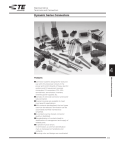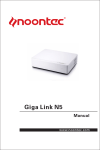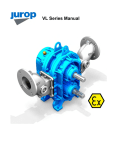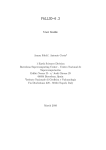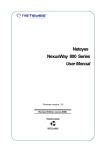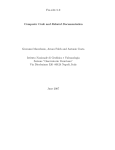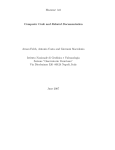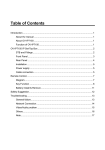Download USER MANUAL
Transcript
NOISELESS SEQUENTIAL AIR SAMPLER FOR INDOOR FACILITIES USER MANUAL JANUARY 2012 Edition – rev.00 FAI Instruments s.r.l. Via Aurora, 15 - 00013 FONTE NUOVA (Roma) Tel. (+39) 06.9050248 (+39) 06. 90532398 Fax (+39) 06. 90539008 [email protected] www.fai-instruments.it All rights reserved. The content of this document is confidential. Any form of transmission is prohibited. Any reproduction of the content of this document, either in whole or in part, is expressly prohibited without the prior consent of FAI Instruments S.r.l. USER MANUAL TABLE OF CONTENTS 1 INTRODUCTION....................................................................................................................... 4 1.1 1.2 1.3 1.4 1.5 GENERAL INFORMATION......................................................................................................................... 4 EQUIPMENT AND MANUFACTURER IDENTIFICATION................................................................... 4 GUARANTEE ................................................................................................................................................. 5 INSTRUCTIONS FOR TECHNICAL ASSISTANCE REQUEST............................................................. 5 INSTRUCTIONS FOR THE SPARE PARTS ORDER ............................................................................... 5 1.6 SILENT SEQUENTIAL AIR SAMPLER CONFORMITY DECLARATION.............................. 6 2. GENERAL SAFETY WARNINGS ........................................................................................... 7 2.1 2.2 2.3 2.4 2.5 2.6 3 SYMBOLS ....................................................................................................................................................... 7 SAFETY WARNINGS.................................................................................................................................... 8 SAFETY REGULATIONS............................................................................................................................. 8 SAFETY LABEL............................................................................................................................................. 8 INTENDED USE OF THE INSTRUMENT.................................................................................................. 9 PRESCRIBED USE ........................................................................................................................................ 9 GENERAL INFORMATION .................................................................................................. 10 3.1 GENERAL INFORMATION ABOUT THE INSTRUMENT................................................................... 10 3.2 INSTRUMENT COMPOSITION................................................................................................................ 10 3.2.1 Sampling unit .............................................................................................................................................. 11 3.2.2 Sampling Inlet............................................................................................................................................. 12 3.2.3 Sequential unit ............................................................................................................................................ 13 4. INSTRUMENT FUNCTIONAL DESCRIPTION ................................................................. 14 4.1 4.2 4.3 5 INSTRUMENT BLOCK DIAGRAM .......................................................................................................... 14 TECHNICAL SPECIFICATIONS .............................................................................................................. 15 SAMPLING CRITERIA .............................................................................................................................. 16 INSTALLATION AND STARTING....................................................................................... 17 5.1. 5.2 5.3 5.3.1 5.3.2 5.3.3 5.4 5.5 5.5 5.5.1 5.5.2 STATE OF SUPPLY ..................................................................................................................................... 17 HANDLING AND TRANSPORTATION ................................................................................................... 18 REQUIREMENTS FOR THE INSTRUMENT INSTALLATION........................................................... 18 Site pre-requirements.................................................................................................................................. 18 Sampling Inlet/s installation ....................................................................................................................... 19 Sampling Unit installation .......................................................................................................................... 20 CONNECTION TO AN EXTERNAL PC ................................................................................................... 22 FILTER MEMBRANES MANAGEMENT ................................................................................................ 23 FILTER MEMBRANES MANAGEMENT ................................................................................................ 23 Filter membranes choice............................................................................................................................. 23 Complete filter composition ........................................................................................................................ 23 6. OPERATING INSTRUCTIONS ............................................................................................. 25 6.1 6.1.1 6.1.2 6.1.3 6.2 6.3 6.4 6.4.1 6.4.2 6.4.3 6.4.4 6.5 6.6 6.7 6.8 6.9 INSTRUMENT STARTING & RUNNING ................................................................................................ 26 Digital flow meter ....................................................................................................................................... 26 Navigation Keypad ..................................................................................................................................... 27 STARTING & RUNNING PROCEDURE ................................................................................................... 28 MAIN MENU STRUCTURE ........................................................................................................................ 29 CURRENT CYCLE SUB-MENU ................................................................................................................. 29 CONFIGURATION SUB-MENU ................................................................................................................. 31 Repetition Period ........................................................................................................................................ 31 INSERT DATA Sub-menu .......................................................................................................................... 32 SET DATE/TIME Sub-menu ..................................................................................................................... 34 CHANGE KEY CODE Sub-menu ............................................................................................................. 35 SHOW BUFFER SUB-MENU ..................................................................................................................... 36 DOWNLOAD BUFFER SUB-MENU ......................................................................................................... 37 ERASE BUFFER SUB-MENU ................................................................................................................... 38 FLOW TEST SUB-MENU ........................................................................................................................... 39 KEYBOARD BLOCK SUB-MENU.............................................................................................................. 41 2 USER MANUAL 6.10 DEVICE INFO SUB-MENU ....................................................................................................................... 41 7. MAINTENANCE ...................................................................................................................... 42 7.1 7.2 7.3 7.4 7.4.1 7.4.2 ROUTINE PREVENTIVE MAINTENANCE ............................................................................................ 42 REPAIRS ....................................................................................................................................................... 43 POSSIBLE ANOMALIES AND RELATIVE SOLUTIONS ..................................................................... 43 INSTRUMENT OUT OF SERVICE ........................................................................................................... 44 Temporary storage...................................................................................................................................... 44 Disposal ...................................................................................................................................................... 44 8. APPENDICES ........................................................................................................................... 45 APPENDIX A ................................................................................................................................................................ 46 3 USER MANUAL 1 INTRODUCTION 1.1 GENERAL INFORMATION The instructions of this manual meet safety, installation, starting and maintenance requirements of SILENT Sequential Air Sampler. FAI Instruments s.r.l. reserves the right to modify the instrument described in this manual. Any update will be enclosed below or may be asked for straight the manufacturer. This manual must be considered integral part of the instrument. It must be always available for the interested personnel. The operators in charge of the instrument installation, running and maintenance must read carefully this manual, in particular Charter 2 about SAFETY. 1.2 EQUIPMENT AND MANUFACTURER IDENTIFICATION The identification label is placed at the back of the instrument sampling unit: Via Aurora, 15 00013 FONTE NUOVA (Roma) ITALY Tel. (+39) 06.9050248 / FAX (+39) 06.90539008 [email protected] SYSTEM: SILENT Sequential Air Sampler Serial Number Year Power supply 230V/50Hz/1.5A Device category: Indoor sampling system of suspended particulate matter on filter membranes. Device identification: SILENT Sequential Air Sampler Via Aurora, 15 - 00013 FONTE NUOVA (Roma) Liable manufacturer: FAI Instruments s.r.l. 4 Tel. (+39) 06.9050248 (+39) 06. 90532398 Fax (+39) 06. 90539008 [email protected] USER MANUAL 1.3 GUARANTEE Fai Instruments s.r.l. products are guaranteed, if they are properly used, from engineering, manufacturing and materials defects that could make them unusable. If no different written agreement is stipulated between Fai Instrument s.r.l. and the Buyer, the guarantee is valid for 1 year as from the forwarding or the delivery date. In case of failure during the guarantee period, FAI Instruments s.r.l. will pay guarantee, at his discretion, repairing or replacing at one’s expense the defective parts. The guarantee doesn’t cover for failures caused by accident, negligence, use of not original spare parts, improper use, installation or maintenance, repairs or repairing attempts carried out by not authorized personnel, normal wear of parts or components, or by any other cause not imputable to Fai Instruments. 1.4 INSTRUCTIONS FOR TECHNICAL ASSISTANCE REQUEST The Customer can always contact the manufacturer for any kind of information about use, maintenance, installation, etc. The Customer is requested to put the questions clearly, referring to this manual and always pointing out the instrument model and serial number mentioned in the identification label. The Technicians qualified to carry out assistance and maintenance repairs are available at the telephone and fax number and at the email address of the manufacturer or of the authorized service center of the area. 1.5 INSTRUCTIONS FOR THE SPARE PARTS ORDER The instrument may eventually need to have wearied or accidentally damaged parts replaced. To this purpose the customer can order the spare parts order for the components to be replaced. Remember that only Qualified Technicians can carry out repairs. The Operator is authorized just to use the instrument and to carry out the routine preventive maintenance operations described in this manual. 5 USER MANUAL 1.6 SILENT SEQUENTIAL AIR SAMPLER CONFORMITY DECLARATION CONFORMITY DECLARATION The manufacturer: FAI Instruments s.r.l. Via Aurora, 15 - 00013 FONTE NUOVA (Roma) Tel. (+39) 06.9050248 06.90532398 Fax (+39) 06.90539008 hereby certifies that the instrument: SILENT Sequential Air Sampler is in accordance with the following European directives, last amendments included, and with the relative national legislation: directive 2006/95/EC about low-voltage electric material directive 2006/42/EC about machinery safety directive 2004/108/EC about Electromagnetic Compatibility and that the following technical regulations have been applied: Safety: EN 61010-1 Safety Requirements for Electrical Equipment for Measurement, Control and Laboratory Use Electromagnetic Compatibility: EN 61326-1 Emission and Immunity EN 61000-3-2 Harmonics EN 61000-3-3 Flicker Person authorized to compile the technical file : Alessandro Trapani FAI Instruments s.r.l. Via Aurora, 15 - 00013 FONTE NUOVA (Roma) The managing director Antonio Cesare Raffaele Imperatore 6 USER MANUAL CHAPTER 2 2. GENERAL SAFETY WARNINGS 2.1 SYMBOLS In this manual the following symbols are used to draw reader’s attention to danger signals. High voltage It marks HIGH VOLTAGE elements. Touching them may be fatal. The inobservance of this warning may expose to electrocution risks. Read carefully Read carefully the text marked by this symbol. The information marked by this symbol are very important for the correct running of the instrument and for the operator’s safety. Warning This symbol is a warning: not observing it may cause instrument damages or it’s incorrect running. 7 USER MANUAL 2.2 SAFETY WARNINGS SILENT Sequential Air Sampler is an air sampler only for indoor facilities. Only trained personnel can operate the instrument. Only technical trained and authorized personnel can carry out interventions inside the instrument. 2.3 SAFETY REGULATIONS SILENT Sequential Air Sampler system has been engineered in such a way to satisfy the requirements listed in the following European directives and their subsequent modifications: Directive 2006/95/EC Low-voltage electric material Directive 2006/42/EC Safety of machinery Directive 2004/108/EC Electromagnetic Compatibility The instrument is in compliance with the following harmonized technical egulations: 2.4 EN 61010-1 Safety Requirements for Electrical Equipment for Measurement, Control and Laboratory Use EN 61326-1 Electromagnetic Compatibility (EMC) – Emission and Immunity EN 61000-3-2 Harmonics EN 61000-3-3 Flicker SAFETY LABEL At the back of the SILENT Sequential Air Sampler system there is the considered a safety label. label that has to be label must not be removed. It must be kept in good readable conditions . 8 USER MANUAL 2.5 INTENDED USE OF THE INSTRUMENT The instrument has been engineered for the following use: to sample in a sequential and automatic way the suspended particulate matter on filter membranes The instrument must be used in the following conditions: indoor environment not potentially explosive or at fire risk atmosphere The instrument must be used only for the operations and in the environmental conditions explicitly described in this manual: any other use is improper and it’s prohibited. 2.6 PRESCRIBED USE The instrument must be used as intended, only in perfect operating technical conditions and by qualified personnel in compliance with current safety and accident prevention regulations. This “User manual” is meant for the Qualified User, who must: verify the operating room and the relative arrangements suitability for the instrument installation/use know in detail all needed operations for the correct use and routine maintenance, all general safety rules and the warnings of this manual do not carry out instrument repairs This "User manual" is also meant for the Qualified Technician, who will be able, following the detailed instructions received during an apposite training course, to carry out instrument maintenance repairs. If needed, for maintenance repairs call the FAI Instruments s.r.l. Technical Assistance Service, or one of its AUTHORIZED technical assistance service center, which can intervene with Specialized Technicians and with fitting tools and original spare parts. Any modification or transformation of the instrument is prohibited. If modifications or transformations are carried out, the operator must take full responsibility for all possible resulting consequences. In case of modifications, we recommend to contact the manufacturer in order to keep the guarantee validity. 9 USER MANUAL CHAPTER 3 3 GENERAL INFORMATION 3.1 GENERAL INFORMATION ABOUT THE INSTRUMENT SILENT Sequential Air Sampler is an indoor sampling system, for suspended particulate matter collected on one filter membrane or sequential sampling on four independent filter membranes. 3.2 INSTRUMENT COMPOSITION The instrument is made up of the following units (see picture 3.1): Sampling unit Sampling line and inlet Optional supply: Sequential unit (optional switching unit for 4 inlets sequential sampling) Additional (3) Sampling Inlets The system can be supplied together with the switching unit suitable for sequential sampling on 4 Sampling Inlets (optional configuration – picture 3.1a) Sampling inlets (4) Sampling inlet Sequential unit Sampling line Sampling line Sampling unit Control cable Sampling unit Noiseless vacuum pump Noiseless vacuum pump Power supply Power supply picture 3.1a picture 3.1 10 USER MANUAL 3.2.1 Sampling unit The unit contains a specially designed noiseless aspiration pump, all sampling control devices. Picture 3.2 shows the frontal view of the unit. Sampling air aspiration line Sampling flow manual adjustment Sampling flow display Sequential unit control cable connector USB connector Keypad Power cord & General Switch Control Display picture 3.2 11 USER MANUAL 3.2.2 Sampling Inlet The sampling inlet has function of impactor for the selected granulometric cut size (PM2.5 or PM10) at the operating flow rate of 10 liter/min . Inlet orifice The sampling inlet unit includes, in cascade, after the impactor section, the filter membrane, mounted in its filter holder, to collect the particulate matter of the selected granulometric cut size. The membrane has a standard size of 47 mm diameter. Note: the impactor has to be greased (with Silicon oil) to hold the bigger size particulate matter. Alternatively a filter membrane 25 mm diameter can be placed on the impactor to collect the bigger size particulate matter Picture 3.3 shows the detail of the sampling inlet. Impactor Inlet section Impactor section Filter holder section Filter holder Filter membrane Sampling INLET (Ø 47mm) picture 3.3 12 USER MANUAL 3.2.3 Sequential unit The sequential unit, connected to the sampling unit, allows the sequential programmable sampling on 4 filters. The sequential unit can be mounted on a tripod stand for photo cameras. Sequential unit box Electrovalve (4) Vacuum inlet (4) Control cable Suction air pipe picture 3.4 Inlets (4) Sequential Unit picture 3.5 13 USER MANUAL CHAPTER 4 4. INSTRUMENT FUNCTIONAL DESCRIPTION SILENT Sequential Air Sampler is an automatic system for the suspended particulate matter sequential sampling, on four independent filter membranes. The technical choices adopted for the instrument SILENT Sequential Air Sampler engineering and manufacturing pursued the following important aims: a. To operate noiseless in the indoor environment, without disturbing possible human quiet activities in the area b. To guarantee a wide usage versatility with the possibility of operating in sequence on four independent sampling inlets. c. To guarantee the keeping of the technical specifications, relevant to air quality control for the suspended particulate matter. d. To guarantee a user friendly interface for the operator and for the technical assistance personnel. 4.1 INSTRUMENT BLOCK DIAGRAM Air inlet Sampling inlets SEQUENTIAL UNIT USB port SAMPLING UNIT Flow DISPLAY (LED) Flow rate adjustment valve DISPLAY & KEYPAD Air outlet CONTROL ELECTRONICS NOISELESS VACUUM PUMP Static Relay picture 5.1 14 24 Vdc POWER SUPPLY Sequential Unit output USER MANUAL 4.2 TECHNICAL SPECIFICATIONS Operating flow rate Adjustable in the range 2 – 12 liter/ min Flow rate measurement reproducibility 1% of the measured value Flow rate measurement relative uncertainty 5% of the measured value Flow rate setting Manual adjustment with regulation valve moved by a knob Sampling Inlet PM2.5 at 10 Liter/min (optionally PM10 at 10 Liter/min) Standard Filter cartridges accepted Standard 47 mm filter membranes for collecting PM2.5 (or PM10) particulate matter to be placed in the filter-holder Additional Filter cartridges accepted Additional standard 25 mm filter membranes for collecting particulate matter > PM2.5 (or PM10) to be placed on the impactor plate Filters capacity (installing the Sequential Unit) No. 4 filter cartridges on four Inlets operated in sequence Storage capacity Buffer data with 50 records (battery backed-up) Power supply 230 V (± 10%) 50 Hz single-phase Absorbed electric power 300 W Operating conditions Indoor environment Storage conditions Temperature between - 20 and + 60 °C Noise level 35 db(A) Sizes(W x D x H) Sampling unit PM2.5 Inlet PM10 Inlet Sequential unit 175 x 410 x 350 mm 65 x 95 mm 65 x 110 mm 210 x 210 x 115 mm Weights Sampling unit 17 kg PM2.5 Inlet 420 g PM10 Inlet 500 g Sequential unit 2.1 kg 15 USER MANUAL 4.3 SAMPLING CRITERIA SILENT Sequential Air Sampler samples the suspended particulate matter, using sampling inlets equipped with a granulometric size fractionating device (impactor) operating at a certain constant volume flow rate. The flow rate is not automatically controlled, but has to be adjusted manually with a valve, looking at the instant flow value indicated by the flow meter integrated with the valve. The flow adjustment has to be performed when the pump has reached steady temperature conditions (see Flow test procedure Par.6.8) The utilized flow meter is a mass flow meter and indicates the flow converted in volume in standard conditions: 20°C, 1 atm. The instrument may be currently equipped with PM2.5 (or PM10 ) sampling inlet/s (granulometric cut size value 2.5 µm (or 10 µm) at 10 liter/min volume flow rate). The operating flow rate value has to be settled accordingly to the sampling inlets characteristics . The particulate matter is collected on a filter membrane 47mm housed inside the inlet (located below the impactor section), manually loaded before the beginning of the sampling cycle. To cover a larger sampling program, up to 4 inlets (each one carrying one filters membrane) can be installed in parallel and programmed for cycles in the desired sequence. At the end of the complete sampling program, or at any intermediate time, after each sampling cycle, the sampled filter/s can be removed from the inlets by the operator for the foreseen analysis. Note 1: The impactor has to be greased (with Silicon oil) to hold the bigger size particulate matter. Alternatively a filter membrane 25 mm diameter can be placed on the impactor plane to collect particulate matter of bigger size than PM2.5 or PM10 Note 2: Inlets of different cut size values, compatible wit the basic Sampling Unit characteristics, can be supplied by FAI Instruments upon request. 16 USER MANUAL CHAPTER 5 5 INSTALLATION AND STARTING During the instrument installation and starting, the operator must carefully follow the safety warnings for use and maintenance and the general SAFETY regulations as mentioned in Chapter 2 of his manual. 5.1. STATE OF SUPPLY If no different specification is present in the contract/order, the instrument is supplied in a standard commercial packaging and with the following configuration: Posit. DESCRIPTION QUANTIT Y 1. CD (including User Manual, Sw for buffer data downloading and firmware updating ) 1 2. Sampling Unit 1 3. Power cord 1 4. Sampling pipe (3 m) 1 5. Tripod for sampling Inlet 1 6. Service filter (for flow meter protection against dirty when testing the instrument without inlet and filter membrane) 1 Optional items (**) 7. Sequential Unit 1 8. PM2.5 sampling Inlet (standard spot area 11.95 cm2) (each inlet supplied with #2 filter cartridges) 1 or 4 9. PM10 sampling Inlet (standard spot area 11.95 cm2) (each inlet supplied with #2 filter cartridges) 1 or 4 (**) Item supplied as provided for by the supply contract 17 USER MANUAL 5.2 HANDLING AND TRANSPORTATION Depending on the transport to be used for the delivery, the instrument will be packaged so as to stand up to possible stresses. At goods receipt verify that no one of the system components has been damaged in transit. In case of damages, signal it immediately at the conveyer man and note it in the freight paper, then contact FAI Instruments s.r.l. The movements needed once the packaging has been removed, can be carried out manually, using the handle. Unpacking the instrument follow these steps: - Open the chests and take out with care the instrument and its attachments. - Collect the chests and all the packaging material and keep it for next storages and/or transportations. 5.3 REQUIREMENTS FOR THE INSTRUMENT INSTALLATION 5.3.1 Site pre-requirements a) The system must be placed in the room, were the sampling has to be performed, with the electric installation in compliance with the electrical standards in force. b) The supply mains socket for the sampling unit connection must be able to supply 230 V 50Hz 1.5A. 18 USER MANUAL 5.3.2 Sampling Inlet/s installation The sampling Inlet alone or the Sequential Unit currying 4 Inlets can be installed on a standard camera tripod using its standard fixing screw. Inlet (bottom view) Sequential Unit (bottom view) Inlet Sequential Unit Tripod picture 5.1 19 USER MANUAL 5.3.3 Sampling Unit installation The sampling unit must be installed inside the room on a horizontal surface (the floor or a table). It’s suitable to leave at least a 15 centimeters space between the instrument lateral panels and the room wall in order to not clog the air inlets and to not limit the ventilation. The position of the sampler must allow the connection to the sampling tube and the control cable, coming down from the inlet / sequential unit, to the sampler. Inlets (4) Sequetial Unit Sampling Unit Aspiration line Sequential unit control cable Power cord picture 5.2 The aspiration line (Ø 8 mm pipe) has to be properly inserted in the two connectors, one on the Sampling Unit and the other on the Sequential Unit (or on the Inlet): insert the pipe pushing in deep tray to pull back the pipe to verify the effective connection Note: To disconnect the pipe, it is necessary, while pulling the pipe, to press the ring of the connector. 20 USER MANUAL Vacuum pump Oil separator Filter 1 Oil separator Filter 2 Valve 1 Electro-valve Valve 2 picture 5.3 On the back of the Sampling Unit are visible and accessible the two lubrication oil filters and the relevant collection sumps. The instrument at regular intervals automatically (activating the electro-valve), empties the right sump (filter 1) and discharge the oil back in the pump. The other sump on the left (filter 2)should not collect oil. In case it happens, the operator shall empty the sump (unscrewing the plug) before the oil reaches one half of the level in the sump. Caution: Empty the sump (unscrewing the plug) before the oil reaches one half of the level in the sump of the filter on the left (filter 2) The vacuum pump inside the Sampling Unit contains lubrication oil, to avoid oil leakage during handling and transportation Valve1 and Valve 2 are to be in closed position . The two valves are to be always opened during the instrument operation . Caution: When the two valves are open, to avoid oil leakage, do not over turn the Sampling Unit Before starting the instrument remember to open the two valves Before any transportation remember to close the two valves 21 USER MANUAL 5.4 CONNECTION TO AN EXTERNAL PC For the connection to a PC use the extractable USB cable, on the front panel of the instrument (see picture 5.4). USB cable (extractable) to the PC USB port picture 5.4 A special software program “SILENT SEQUENTIAL AIR SAMPLER DOWNLOADER “ supplied by FAI Instrument, can be installed in the PC to download the buffer data from the instrument (see Appendix A) 22 USER MANUAL 5.5 FILTER MEMBRANES MANAGEMENT 5.5.1 Filter membranes choice The choice of the filtering mean depends on: - chemical characteristics depending on the possible need of a particulate matter sample chemical characterization (ion analysis, metals, IPA…) - mechanical characteristics - costs The choice of the filter membrane must result from the best compromise between analytical needs, sampling needs and management costs. The following standard filter membranes Ø 47mm, of different manufactures, are normally used : Fiber glass Quartz Teflon™ For more specific information, or for the direct supply of filter membranes, contact FAI Instruments Technical Assistance. 5.5.2 Complete filter composition A complete filter is made up of a filter membrane placed in a filter cartridge made up of two circular discs, of two different colors, pressure coupling and keeping inside the filter membrane. Picture 5.5 shows the complete filter composition. Upper disc Filter (complete) Filter cartridge upper disc filter membrane Filter cartridge lower disc picture 5.5 23 Lower disc USER MANUAL The filter membrane must be inserted in the upper disc and the lower disc has to be coupled on the upper disc pressing with the fingers to assure a tight enclosure. Once coupled the two discs, the lower part of the complete filter is hollow (see picture 5.6 and picture 5.7). Inserting the filters inside the Inlet, make sure that the filter cartridge has the hollow part turned downwards . Lower hollow surface Flat enrichment surface picture 5.6 Section of a complete filter Upper disc Lower disc picture 5.7 For the filter cartridge correct positioning, the significant element is its shape. The complete filter must be inserted inside the Inlet with the hollow part turned downwards. The colour of the filter cartridge discs is not relevant for the filter cartridge positioning inside the Inlet (FAI Instruments supplies filter cartridges with different colour couplings: white-black, red-.black, etc.). 24 USER MANUAL CHAPTER 6 6. OPERATING INSTRUCTIONS Only personnel trained as “Qualified Operator” can use SILENT Sequential Air Sampler and this personnel is bound to: verify that the room and the relative arrangement are fitting for the instrument installation/use know in detail all needed operations for the correct use and routine maintenance and all the general safety regulations and the instructions mentioned in this manual do not carry out instrument repairs. Only “Qualified Technical” personnel, appropriately trained and authorized, can carry out instrument repairs on the basis of detailed technical instructions received in an apposite training course and using original spare parts. 25 USER MANUAL 6.1 INSTRUMENT STARTING & RUNNING Sampling air aspiration line Digital flow display Sequential unit control cable connector USB connector Keypad Power cord & General Switch Control Display picture 6.1 6.1.1 Digital flow meter Flow adjustment valve Flow Led display picture 6.1a 26 USER MANUAL 6.1.2 Navigation Keypad UP KEY • • RIGHT KEY LEFT KEY • • ENTE ENTER R • • ENTER KEY • • DOWN KEY • • • 27 USER MANUAL 6.1.3 STARTING & RUNNING PROCEDURE Power switch ON Open valves (back of the instrument) MAIN MENU Set date & time Par.6.4.3 Erase buffer Par.6.7 Set Configuration Par.6.4 Flow test Par.6.8 Keyboard lock Par.6.9 START Current cycle Device info Par.6.10 Current cycle running Insert sampling data Par.6.4.2 Set repetition period Par.6.4.1 Sampling FLOW Adjustment (manual) Current cycle status Par. 6.3 Buffer data Par.6.5 Cycle Ending or STOP Download Buffer data Par. 6.6 28 USER MANUAL 6.2 MAIN MENU STRUCTURE Switching on the instrument, the FAI Instrument logo appears on the display and immediately after the main menu is presented. Sub-menu selection cursor Sub-menu item CURRENT CYCLE SUB-MENU 6.3 In Level 1 sub-menu CURRENT CYCLE it is possible: • • • ! ! ! " " # CURRENT CYCLE Date 14/12/11 Line Start Stop Volume Status ESC Time 13:45 2 Flow 10/12/11 16/12/11 005.230 00000001 02.05 08:00 15:20 [cm] Stop • • There are two possible options selectable with the cursor __ Pressing ENTER : $ " The sampled volume reported in the Current cycle sub-menu is updated every minute, while the instant flow is updated every 5 seconds. 29 USER MANUAL In the following table the single field of information, relevant to the cycle in execution; are described. DESCRIPTION FIELD Sampling line identification Sampling starting date and time (as programmed) Sampling ending date and time (as programmed) Total air volume sucked from the start to the visualized instant, in liters [L] Information on the sampling cycle Status (Field of 8 Bit) : Bit [0] (first on the right) Bit [1] (second from the right) Bit [2] (third from the right) 1 In sampling 0 Not in sampling 1 Cycle already concluded 0 Cycle not yet concluded 1 Cycle resumed after a Power Off 0 No Power Off during the Cycle Reserved fields Bit [3÷7] NOTE: In the field STATUS, Bit [0] will be always 1, and Bit [1] will be always 0, as the given information in this sub-menu is related to a still running cycle . Different situation will be in the field STATUS of the Show buffer sub-menu (see Par. 6.5 ) 30 USER MANUAL CONFIGURATION SUB-MENU 6.4 In Level 1 sub-menu CONFIGURATION it is possible: • • • • • • ! ! ! ! ! ! " % % * * * " &' ( )) " " ! " CONFIGURATION $ " $ # ESC Date Time 14/12/11 09:35 Rep. every 12 days Save rep. period 03 steps configured Insert data [+] Set date/time [+] Change key code [+] The navigation inside the sub-menu is possible using the buttons UP or DOWN cursor in the desired position and pressing ENTER for the actuation. 6.4.1 Repetition Period • " # $ " " " +, - ./ ' ( )) " #! ENTER 0 # ENTER 0 • Date and time from which the next programmed cycle block will be repeated Option Yes CYCLE REPETITION ESC Option ESC Do you wish to set next cycle block on 31/01/12 at 09:00 ? Y / N 31 Option No , positioning the USER MANUAL 0 CYCLE REPETITION ESC Option ESC Do you wish to stop cycle block repetition? Y / N Option Yes Option No 6.4.2 INSERT DATA Sub-menu The level 2 sub-menu Insert Data allows to program the sampling cycles and it has the following structure: Identification of the sequential level of the selected sampling cycle Identification of the sampling Line (1÷4) Legend Sampling STEP #1 On Line 1 L 1 Sampling STEP #2 On Line 3 Sampling STEP #3 (Not active) Option Rst (RESET) • 1 Sampling Line 1 3 % & STEP # 02 Start DD/MM/YY hh:mm 14/12/11 08:30 3 14/12/11 17:30 04:00 0 00/00/00 00:00 00:00 Rst Quit Save Ers Option Quit (QUIT) 0 Duration hh:mm 04:00 Sampling parameters of cycle STEP #1 Sampling parameters of cycle STEP #2 Option Save (SAVE) Option Ers (ERASE) " Sampling start date 14/12/11 14/12/11 Sampling start time 08:30 17:30 !! !! Sampling duration 4 ore 4 ore ' 32 USER MANUAL The navigation inside the sub-menu is possible using the keyboard for positioning the cursor ( or ) in the desired position using the buttons UP or DOWN , for field value incrementing/decrementing pressing ENTER for entering the different programming steps. The following options are possible: •" •( • ! ' $ " 0 Sampling cycle config. saving completed! 2 Sampling cycle config. saving failure! " 0 # # , ENTER # 2 ) % / 0 2 " 0 $ 33 " 0 USER MANUAL 6.4.3 SET DATE/TIME Sub-menu The level 2 sub-menu Set date/time allows : o o ! 4 3 $ !4 # The sub.menu has the following structure: SET CURRENT DATE/TIME Current Date Current Time DD/MM/YY 14/12/11 0 SAVE AND QUIT RTC alarm 1 Status HH:MM 15:01 0 CLEAR QUIT Option Save and quit RTC alarm 2 Status Option Clear Option Quit Below the date and time row, RTC alarm status is shown corresponding to the starting time and to the ending time of a sampling cycle. The navigation inside the sub-menu is possible : using the keyboard for positioning the cursor ( or ) in the desired position using the buttons UP or DOWN , for field value incrementing/decrementing pressing ENTER for entering the selection. The following options are possible: • RTC alarms are • • * ( - '# ! $ 4 " 34 USER MANUAL 6.4.4 CHANGE KEY CODE Sub-menu The level 2 sub-menu Change key code allows to modify the code to unlock the keypad, eventually to be done having locked the keypad with the sub.menu Keyboard block The sub.menu has the following structure: Old Code field New Code field New Code field , ENTER 4 KEY CODE MODIFY ENTER OLD CODE: **** OK! ENTER NEW CODE: **** OK! CONFIRM NEW CODE: **** OK! KEY CODE CHANGED! PRESS ENTER $ 4 0 Sequential images confirming right Codes inserted Final message # $ 35 # USER MANUAL 6.5 SHOW BUFFER SUB-MENU In Level 1 sub-menu SHOW BUFFER it is possible to show the memorized data of each sampling cycle already concluded. The sub-menu has the following structure: DATA BUFFER ESC UP/DOWN = SCROLL BUFFER ENTER = QUIT Navigation instruction START STOP VOLUME STATUS 02/01/12 06:00 04/01/12 18:45 005.23 [CM] 00000010 PG 01 Option ESC Sampling cycle information: Starting date and time Ending date and time Total sampled Volume Status Page Number Buttons UP and DOWN , allow to scroll the pages in sequence (up to 50 pages). Every page has the data relevant to a specific cycle . Buttons LEFT and RIGHT allow to jump 10 pages at once. Press ENTER on the option ESC to go back to the Main menu. 36 USER MANUAL 6.6 DOWNLOAD BUFFER SUB-MENU In Level 1 sub-menu DOWNLOAD BUFFER it is possible to download the buffer utilizing the USB port of the instrument. The sub-menu has the following structure: DOWNLOAD BUFFER ESC Option ESC DOWNLOAD BUFFER DATA? Option Yes Option No Y / N The navigation inside the sub-menu is possible : using the buttons LEFT or RIGHT for positioning the cursor ( position pressing ENTER for entering the selection. or _) in the desired Press ENTER on the option : • • $ ) / ! 6 ,4 + 5 # 2 0 • % $ 0 $ $ %+, . * / / ! 0' 1/" 37 ! USER MANUAL 6.7 ERASE BUFFER SUB-MENU In Level 1 sub-menu ERASE BUFFER it is possible to cancel the buffer data containing all the information related to the sampling cycles already performed and concluded. The sub-menu has the following structure: ERASE BUFFER ESC THIS OPERATION Option ESC WILL ERASE THE WHOLE BUFFER STORAGE AREA. PROCEED? Y / N Option Yes Option No The navigation inside the sub-menu is possible : using the buttons LEFT or RIGHT for positioning the cursor ( position pressing ENTER for entering the selection. or _) in the desired Press ENTER on the option: • • to go back to the ) to erase the buffer data At the end of the cancellation, the results of the operation are shown: 0 • % $ to avoid the cancellation, going back to the sub-menu 38 USER MANUAL FLOW TEST SUB-MENU 6.8 • • In Level 1 sub-menu FLOW TEST it is possible : To run a flow verification test comparing the value shown by the instrument on its main display, with the one manually adjusted on the flow valve and readable on its flow meter To calibrate the instrument setting and storing the calibration values for the A/D converter (with these values successively the instant flow will be calculated in [L/min] and consequently will be calculated 3 the total air volume in [m ] sucked by the instrument) The sub-menu has the following structure: Option ESC Option Start test Option Stop test Option Start cal. #0 Option Start cal. #1 FLOW TEST START TEST STOP TEST INST. FLOW Instant flow value in [l/min] during a flow test (not active during calibration) ESC 000.000 L/mn 02.00 L/mn 10.00 0000 SAVE START CAL. ADC VALUE STOP CALIB. Option Stop calib. Option Save The navigation inside the sub-menu is possible : using the buttons UP or DOWN , for positioning the cursor ( position pressing ENTER for entering the selection. Field reserved for calibration #0 flow value setting Field reserved for calibration #1 flow value setting ADC value in [LSb] shown during test or calibrations or __ ) in the desired The following options are possible: • • • 23 • 2- • • • Sampling on the line #1 starts and the instant air flow value in [L/min], red by the instrument, is shown in the field Inst. flow Sampling on the line #1 stops Calibration for flow value starts and the numerical sample calculated by the A/D converter is shown in the field ADC Value in [LSb]. Calibration for flow value starts and the numerical sample calculated by the A/D converter is shown in the field ADC Value in [LSb]. Calibration action is completed Calibration parameters are fixed in the instrument memory $ Pressing ENTER it is possible to insert the desired values : using the buttons UP or DOWN for flow value increasing or decreasing from a minimum of 0.0 [L/min] to a maximum of 25.0 [L/min], in step of 1.0 [L/min]. Press ENTER again, to exit the field. 39 USER MANUAL The flow verification test allows to compare the value shown on the flow meter (taken as reference) with the value shown by the instrument and utilized for the sampled air total volume calculation. The calibration allows to minimize the difference between the two values. It is recommended, to avoid erroneous air volumes calculations, to calibrate the instrument before any sampling cycle program takes pace. and , through which passes the The calibration defines a couple of points straight line that describe mathematically the relation between the numerical sample of the A/D converter and the instant air flow. • The calibration procedure is as follows: Set the first calibration point (flow value • Start the calibration with Start cal and manually adjust the flow valve on the flow value • Wait at least 5 seconds to allow to the instrument the correct reading of the flow. The corresponding value read by the A/D converter ( , in [LSb]) is shown in the corresponding field • • Finish the calibration of the first point with Stop calib in [l/min] for calibration #1); it is not necessary to use Set the second calibration point (flow value a bigger value with respect to the first calibration point #0 Start the calibration with Start cal and manually adjust the flow valve on the flow value • in [l/min] for calibration #0) • Wait at least 5 seconds to allow to the instrument the correct reading of the flow. The corresponding value read by the A/D converter ( , in [LSb]) is shown in the corresponding field • • Finish the calibration of the second point with Stop calib Save the calibration parameters with Save • The mass flow decreases of about 10 % when the pump has warmed up to steady temperature conditions with respect to the ambient temperature. Operating the pump when the pump is close to the ambient temperature, the flow value adjustment should be increased of 10 % (see Note 1) • To avoid flow meter damage due to unfiltered air flow, don’t run the instrument without filters (see Note 2) NOTE 1: It is possible to warm up the instrument outside a sampling cycle entering the Start test option of the TEST FLOW menu NOTE 2: To avoid the squandering of operative filter membranes (installed in the Inlet), the Service Filter supplied with the instrument may be used, connecting it at the input of the instrument in place of the Inlet line. 40 USER MANUAL 6.9 KEYBOARD BLOCK SUB-MENU In Level 1 sub-menu Keyboard block it is possible to prevent not authorized personnel to operate the instrument, locking the navigation through the keypad. Anyway the programmed sampling cycle sequence continues. Restoration of navigation functionality may be obtained inserting the default key code or the code previously inserted by the user in the sub-menu Change key code. KEYBOARD LOCKED Field reserved for key code insertion ENTER KEY CODE: .... 6.10 DEVICE INFO SUB-MENU In Level 1 sub-menu Device info , the information strictly related to the instrument is presented: • • • • 7 8 : 9 9 / DEVICE INFO MODEL HW VER. FW VER. S/N SILENT AIR SAMPLER 00.00.01 01.00.00 000047 The only option shown is ESC. Press ENTER to go back to the Main Menu. 41 ESC USER MANUAL CHAPTER 7 7. MAINTENANCE The maintenance interventions must be carried out only by qualified personnel, considering general warnings specified in Chapter 1 of this manual. The instrument maintenance is subdivided into Routine preventive maintenance and Repairs: a. routine preventive maintenance must be carried out by control and maintenance trained personnel entrusted with the instrument. b. maintenance repairs can be carried out by technical personnel trained for the assistance, or by the technicians of the FAI Instrument s.r.l. Technical Assistance Service (see section 8.2 - Repairs). 7.1 ROUTINE PREVENTIVE MAINTENANCE To preventive maintenance belongs the routine system management, including surveillance and cleaning operations, and all the checks that the operators will perform during the normal instrumental operating cycle. Recommended check and preventive maintenance interventions are listed in the table below: Intervention type Recurrence 1 Sampling inlets cleaning and greasing Every sampling session 2 Check filter cartridges status Every 100 working hours 3 Substitute filter cartridges Every 1000 working hours 4 Pump Oil level check and eventual refilling Every 1000 working hours 3 Measurements quality tests and checks Yearly The instrumental operating conditions may be very different in time. Therefore we recommend to carry out the interventions at intervals fitting to the real use conditions, considering the recurrences of the table above as an indicative reference. 42 USER MANUAL 7.2 REPAIRS Maintenance repairs must be carried out only by qualified Technical personnel (see Chapter 1 of this manual). With repairs we mean the interventions needed to go back to the normal instrument running conditions after failures. Maintenance repairs can be carried out only by: Qualified Technician who can carry out instrument maintenance repairs on the basis of detailed technical instructions received during apposite training course FAI Instruments s.r.l. Technical Assistance Service Authorized technical assistance center Instrument modifications and transformations are prohibited. In case of modifications and transformations the user must take full responsibility for all possible resulting consequences. In case of modifications, we recommend to contact the manufacturer in order to keep the guarantee validity. 7.3 POSSIBLE ANOMALIES AND RELATIVE SOLUTIONS The table below sums up in a scheme the intervention modalities and some typical hitches. ANOMALY POSSIBLE CAUSE SOLUTION The instrument doesn’t switch on The instrument is not correctly powered Check the socket and the power cord Check the fuses and if needed replace them The instrument doesn’t keep date and time Internal battery not charged (it may Wait some time after the switch ON, to allow happen after a long not operating battery recharging period ) Exhausted internal battery Apply to technical assistance The instrument does not communicate with the PC Connection cable or PC malfunction Verify the connection between the instrument and the PC USB port Instrument - PC communication problems Wrong interface program setting on the PC Verify that the PC setting is correct (as detailed in the procedure given in Annex 1 of the Manual) 43 USER MANUAL 7.4 INSTRUMENT OUT OF SERVICE At the end of the instrumental operating life, it’s necessary to get rid of it without causing dangers for the people and without damaging the environment 7.4.1 Temporary storage The instrument, if possible in its original packaging, must be stored indoors, in horizontal position, no other weights must rest on it. The storage temperature must be kept between - 10 and + 60 °C in order to avoid damages to the parts in synthetic material and to the electronics. The storage relative humidity value is not important, as long as there is no condensation. 7.4.2 Disposal In case of instrumental final dismantling, disassemble it selecting the materials depending on their type. The main components that can be disassembled are: Various metallic materials (aluminum, carbon and stainless steel, copper) Plastic materials Electric and electronic components Elastomers Batteries The wreckage must be committed to specialized firms, depending on its type and dangerousness, in conformity with current regulations. If possible, the material must be recycled. 44 USER MANUAL CHAPTER 8 8. APPENDICES Appendix A SILENT SEQUENTIAL AIR SAMPLER DOWNLOADER -- SOFTWARE FOR EXTERNAL PC 45 USER MANUAL Appendix A SILENT SEQUENTIAL AIR SAMPLER DOWNLOADER SOFTWARE FOR EXTERNAL PC Tools Menu About Menu Open port Button Get COM ports list Button COM port settings Panel COM list Scroll menu Baud rate Scroll menu COM status Group Parity Scroll menu Connected Box Disconnected Box Stop bits Scroll menu Buffer records table Data bits Scroll menu Save to Hard Drive Button Quit Button Clear table Button Fig. 1. Silent Sequential Air Sampler Downloader graphical user interface. SOFTWARE INSTALLATION REQUIREMENTS • ! o o o o • 4 o $ < . . . . ! " " ;+ $ =3 7 3 • . A " ?, , , $ " $ $ 0 , $@ 3 $ < " #3 " $ " 8B CDA 42AD7248 / E :!.2 " # $%&'( #/ ! : 0 $ • . 3 *''@0 #/ ! : 7 7 " *''>3 "3 9 ?, 8 . 0 0 E7 F 3 (%)* % 0 '0 E/ ! : 7 G 4- : 3 46 $ #/ ! : E/-,E <E: $ 1 3 < USER MANUAL • G 7 (%)* % 0 1 9 4HH *'6' " $ 0 " 4- 3 • : # USB CONNECTION WITH SILENT SEQUENTIAL AIR SAMPLER DEVICE 6# *# 4 . . @# ! <# 4 $ 3 $ $ L# + 5 F F " $ 0 " " 1 F . $ " / " "0 $ + + IJK / 3 :!- + 5 0 , -. + 1 0 + . -2 + 3 0 $ , . + 0 $ 4 M# 0 $ =# ># + 5 # % NL $ 0 $ ($5 ( 0 . $ . 3 4- 3 NM 3 ! " 1 + 5 4 7 # $ -2 + 6+5 -2 " DOWNLOAD OF BUFFER DATA 6# 4 0 F " 0 *# 3 7 4 $ 3 + 5 + 5 -2 . ! " " " " 3 @# <# 4 7 $ N>3 4 $ 1 -2 + 3 - . 0 ! " 1 -2 $ $ L# ! O P " 4 7 8 -2 5 9 & )M'' O 3 47 P0 , "&/ -2 0 &6O P0 " &> F USER MANUAL M# ! 0 0 0 " 4 0 /! 0 $ " $ =# . ! ! 9 " : ># : 1 " " " 1 0 $ $ " 3 ; Fig. 4.Saving buffer data to text file dialog window. Change the file name (if the default one Sampler_Buffer shown isn’t desired), select the destination folder and click on the Save button; on success, the following message will be shown: Fig. 5. Saving buffer data to text file process correctly completed pop-up message. 0Q $ 4 # 0 " 0 + 5 " $ 3 66# : "0 0 $ < # )# ! 6'# . $ 48 0Q 4 7 " USER MANUAL FIRMWARE UPGRADING 6# 4 0 F " 0 3 + 5 + 5 . ! " " 3 *# 4 7 0 @# " $ 4 $ 5 3 62 $ F " 0 . Select binary file button LM Flash Downloader path text box Select LM Flash path button Flash Micro button Close button 4 $ I# K 1 $ Fig. 6. Firmware upgrading tool. Q " 4 " 0 . " 0 $ 1 62 $ 62$ . $ . 2 . % 0 0 62 $ 4/"% %5 . 0 . 3 0 13 Q - $ . . 1 1 . 62 $ 4 $ 1 " - L# M# 4 7 3 Binary file path text box <# 0 1 13 0 $ # # $ &" "'" 49 #$ % $


















































